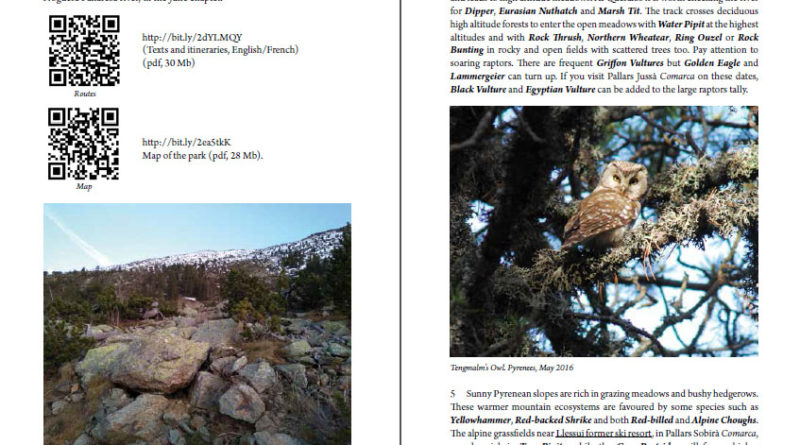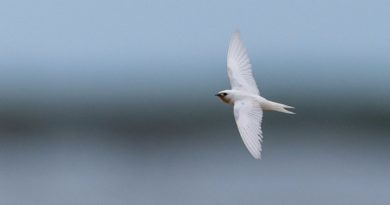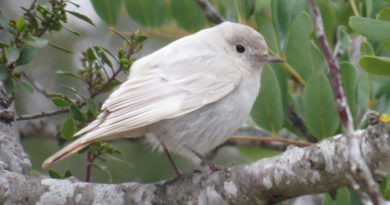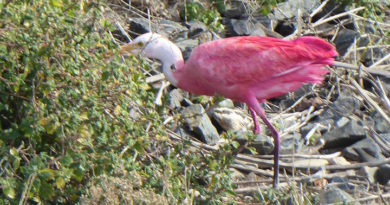When and where to watch birds in Catalunya
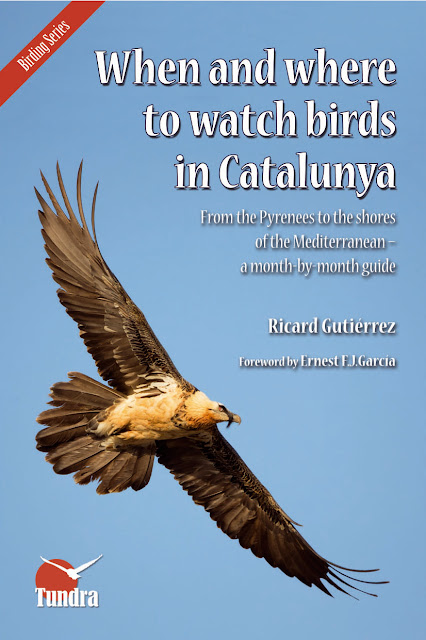 |
| Cover with the stunning Lammergeier photo from Oriol Muntané |
Published in early April 2017, When and Where to Watch Birds in Catalunya is the new book from Tundra Ediciones, the Spanish leading nature related books publisher. Written by this blog and Rare Birds in Spain website author, Ricard Gutiérrez, the book is foreworded by GONHS’ Gibraltar Bird report editor Dr. Ernest F J Garcia.
Here we’ll deal with a complete review of its contents aimed to perhaps encourage you to order one copy of this 378 pages long brand new guide to perhaps one of the best birding places in SW Europe.
Did you know that 443 bird species have been
seen in Catalunya and that their number changes every month? Did you know that Catalunya
holds the current European record of most birds seen in 24 hours, well
exceeding 210 species? Can you imagine waking up in the snow-covered Pyrenees
with Tengmalm’s Owl, Citril Finch or Lammergeier, visiting the open grassland
at midday with Little Bustard, a diversity of larks, both Sandgrouse, Black
Wheatear or Montagu’s Harrier, then ending the day on the Mediterranean coast
with Greater Flamingo, Audouin’s and Slender-billed Gulls or offshore shearwaters? This is only possible in Catalunya. And this is the book to have if
you want to enjoy the bird diversity of this rich country on a monthly basis.
seen in Catalunya and that their number changes every month? Did you know that Catalunya
holds the current European record of most birds seen in 24 hours, well
exceeding 210 species? Can you imagine waking up in the snow-covered Pyrenees
with Tengmalm’s Owl, Citril Finch or Lammergeier, visiting the open grassland
at midday with Little Bustard, a diversity of larks, both Sandgrouse, Black
Wheatear or Montagu’s Harrier, then ending the day on the Mediterranean coast
with Greater Flamingo, Audouin’s and Slender-billed Gulls or offshore shearwaters? This is only possible in Catalunya. And this is the book to have if
you want to enjoy the bird diversity of this rich country on a monthly basis.
If you are a resident planning a weekend trip that
particular month or a visitor in search of anything to look for during your
holiday, the book gives advice on different places and ideas and tips for
mountain, Mediterranean and coastal habitats and sites. The full Catalunya bird list is quoted in the
book, with special attention to the must-see specialities and scarce birds
month by month.
particular month or a visitor in search of anything to look for during your
holiday, the book gives advice on different places and ideas and tips for
mountain, Mediterranean and coastal habitats and sites. The full Catalunya bird list is quoted in the
book, with special attention to the must-see specialities and scarce birds
month by month.
The book includes:
- References to all bird species recorded in Catalunya
- 24 maps with suggested itineraries, including details of 22 observation towers, 31 hides, 92 viewing points or stakeouts and 149 suggested birdwatching areas.
- QR codes to be scanned with your mobile phone giving access to websites, downloadable documents or mobile apps.
- Many internet links to further resources linked with book contents
- A list of 187 specific locations underlined in the book with GPS directions covering all Catalunya comarcas.
- A complete list of other resources for preparing your visits
- The updated Catalunya bird list
- A comarca-based appendix with further useful resources and information, downloadable maps and QR links, bird-richness maps and site lists.
- Current big-year records for every category in Catalunya.
The text above is that of the back cover of the book. One of its aims is to give ideas for
birdwatchers, allowing them to plan future trips depending on the time of the
year and to encourage the old-fashioned way of ‘looking for birds’ rather than
‘waiting for others to find them’ so I can twitch them.
birdwatchers, allowing them to plan future trips depending on the time of the
year and to encourage the old-fashioned way of ‘looking for birds’ rather than
‘waiting for others to find them’ so I can twitch them.
The book contains proposals both for
the average birder but also for the keen aficionado in search of the rare or more
interesting species. Guidelines are given for both so everyone can take advantage
of any weekend visit, business trip, or holiday period regardless of whether
it’s summer, winter, spring or autumn.
the average birder but also for the keen aficionado in search of the rare or more
interesting species. Guidelines are given for both so everyone can take advantage
of any weekend visit, business trip, or holiday period regardless of whether
it’s summer, winter, spring or autumn.
 |
| Index of contents showing the book structure |
The book is divided into four parts.
- The initial part includes an introduction and ensuing chapters (pages 1 to 36).
- The second part
is the main core of the book, dealing with each of the twelve months of the
year in turn (pages 37 to 270). - A third section including external resources and acknowledgements (pages 271 to 278).
- A final set of appendixes covering the Catalan bird list, the list of
locations mentioned along the book and a set of files including useful
information organized on a comarca basis. A species index (with both scientific and
English names) is included too (pages 279 to 378).
The book is plenty of graphs, photos, maps and QR codes all from the author. Besides, Xavier Riera provided a stunning Wallcreeper photo (see below) and Oriol Muntané four more images including the Lammergeier cover. Both authors kindly provided them for the book.
Catalunya has a great variety of
reliefs but it is basically a mountainous country located in NE Iberian
Peninsula. There are the Pyrenees in the north. A number of coastal mountain
ranges run north-south, some close to the sea, others a bit inland. The coast
is rocky in the north (the so-called Costa Brava) and becomes sandy towards the
centre and the south. And there are coastal wetlands at each end and in the
middle: north to south the Aiguamolls de l’Empordà, Llobregat delta and the
large Ebre delta. To complete the panorama, the central depression lies well
inland, phasing in with the Ebro river basin expanding into Aragón and beyond.
This essentially flat area does not contact with the main Pyrenean axis but
with chalk, raptor-rich Mediterranean mountain ranges constituting the Pre-Pyrenees.
reliefs but it is basically a mountainous country located in NE Iberian
Peninsula. There are the Pyrenees in the north. A number of coastal mountain
ranges run north-south, some close to the sea, others a bit inland. The coast
is rocky in the north (the so-called Costa Brava) and becomes sandy towards the
centre and the south. And there are coastal wetlands at each end and in the
middle: north to south the Aiguamolls de l’Empordà, Llobregat delta and the
large Ebre delta. To complete the panorama, the central depression lies well
inland, phasing in with the Ebro river basin expanding into Aragón and beyond.
This essentially flat area does not contact with the main Pyrenean axis but
with chalk, raptor-rich Mediterranean mountain ranges constituting the Pre-Pyrenees.
There is a huge scope for birds in an
almost 32.000 km2 area that allows
you to start the day watching the sun rise over the snow clad peaks of the
Pyrenees while listening to the Tengmalm’s Owl and end up in the Mediterranean deltas
watching shearwaters from the coast. With a good communications
network, a wide-ranging, internet-driven source of information and the network
of protected areas, it’s an ideal destination for those seeking rare species in
the Iberian context, for those who come to the Peninsula from the north and for
those who live here, all of this thanks to the extraordinary variety of
habitats and species.
almost 32.000 km2 area that allows
you to start the day watching the sun rise over the snow clad peaks of the
Pyrenees while listening to the Tengmalm’s Owl and end up in the Mediterranean deltas
watching shearwaters from the coast. With a good communications
network, a wide-ranging, internet-driven source of information and the network
of protected areas, it’s an ideal destination for those seeking rare species in
the Iberian context, for those who come to the Peninsula from the north and for
those who live here, all of this thanks to the extraordinary variety of
habitats and species.
 |
| Montagu’s Harrier Circus pygargus photo featured in April chapter (Ricard Gutiérrez) |
How many birds
can we find in Catalunya?
can we find in Catalunya?
443 species from 74 families have been
recorded in Catalunya so far.
recorded in Catalunya so far.
Many of the 443 species are common elsewhere in
Europe; others may be either endemic to southern Europe or typically considered
as a coveted species for visitors from other climes. We have selected a set of
100 species amongst the total which might be the main targets for visitors from
abroad. Emphasised with a bold number in Appendix 1, they range from endemic
forms such as Iberian Green Woodpecker or Witherby’s Reed Bunting to southern
European specialities such as Red-necked Nightjar, Thekla
Lark, Roller, Little Bustard, Lammergeier or Audouin’s Gull.
Europe; others may be either endemic to southern Europe or typically considered
as a coveted species for visitors from other climes. We have selected a set of
100 species amongst the total which might be the main targets for visitors from
abroad. Emphasised with a bold number in Appendix 1, they range from endemic
forms such as Iberian Green Woodpecker or Witherby’s Reed Bunting to southern
European specialities such as Red-necked Nightjar, Thekla
Lark, Roller, Little Bustard, Lammergeier or Audouin’s Gull.
Catalunya month by month
Every month chapter includes in turn a
global introduction (see an example above) to what the month
represents from the birdwatching point of view. After this, a set of proposals are
detailed in two different sections:
global introduction (see an example above) to what the month
represents from the birdwatching point of view. After this, a set of proposals are
detailed in two different sections:
• General birding tips, includes
regular events such as the arrival or departure of certain migrants. References
to species and when and where to see them are detailed but also some
suggestions to specific sites throughout Catalunya. Those places, underlined in
the text and detailed with GPS coordinates in appendix 2,
can also be visited in any other part of the year, but the proposed dates
coincide with some particular event or period such as migration, breeding
season etc.
regular events such as the arrival or departure of certain migrants. References
to species and when and where to see them are detailed but also some
suggestions to specific sites throughout Catalunya. Those places, underlined in
the text and detailed with GPS coordinates in appendix 2,
can also be visited in any other part of the year, but the proposed dates
coincide with some particular event or period such as migration, breeding
season etc.
• Tips for keen birders and rarity
aficionados, including detailed information on the scarcer species likeliest to turn
up that month. Almost regular, albeit scarce, birds are included and some
histograms, charts and maps are provided too. A list of the top rarities found
every month is also included, and a ‘rarity’ forecast involving the most likely
future additionsto the Catalan list to whet the appetite of the most inveterate
twitcher.
aficionados, including detailed information on the scarcer species likeliest to turn
up that month. Almost regular, albeit scarce, birds are included and some
histograms, charts and maps are provided too. A list of the top rarities found
every month is also included, and a ‘rarity’ forecast involving the most likely
future additionsto the Catalan list to whet the appetite of the most inveterate
twitcher.
All bird species included in the main text are
highlighted in italic bold letters to make them stand out.
highlighted in italic bold letters to make them stand out.
 |
| Pages 120-121 covering part of the Pyrenees species and providing links to further resources from Nature Parks in the area. Georeferenced locations are underlined and species are in bold italics |
 |
| An example of a chart showing the migration patterns of Little and Baillon’s Crakes (Porzana parva, P.pusilla) |
You will find references to locations or place names
throughout the book. The commoner ones, such as town or large sierras names,
can be found in maps or the internet. A set of more specific places appear
underlined and are included in appendix 2, showing both their native Catalan
name and, wherever applicable, their English meaning. Appendix 2 includes 187
places, with details on the town council they belong to, comarca, province and
UTM datum ETRS89 GPS coordinates.
throughout the book. The commoner ones, such as town or large sierras names,
can be found in maps or the internet. A set of more specific places appear
underlined and are included in appendix 2, showing both their native Catalan
name and, wherever applicable, their English meaning. Appendix 2 includes 187
places, with details on the town council they belong to, comarca, province and
UTM datum ETRS89 GPS coordinates.
The book also includes references to internet resources, either webpages
or documents. Some of these external links are accessible through a QR Code that can be
scanned from your handheld, either smartphone or tablet.
or documents. Some of these external links are accessible through a QR Code that can be
scanned from your handheld, either smartphone or tablet.
The book is designed to awaken
curiosity and to be useful for a wide range of visitors to Catalunya that may
have a different degree of interest in nature
curiosity and to be useful for a wide range of visitors to Catalunya that may
have a different degree of interest in nature
and
birds.
birds.
The book includes 24 itineraries with
site maps covering
locations of interest for our remit here. All maps have been specially drawn up
for this book by the author on the basis of the official maps from the Catalan
Cartographic and Geological Institute (http://www.icc.es).
site maps covering
locations of interest for our remit here. All maps have been specially drawn up
for this book by the author on the basis of the official maps from the Catalan
Cartographic and Geological Institute (http://www.icc.es).
The 144.53 km long
routes are dotted
in the maps with different colours according to access type and path characteristics. Other maps
of the different comarcas or tourist points of interest are linked in Appendix
3 including QR codes for tablets or smartphones too.
routes are dotted
in the maps with different colours according to access type and path characteristics. Other maps
of the different comarcas or tourist points of interest are linked in Appendix
3 including QR codes for tablets or smartphones too.
The book also includes in appendix 1 the Catalan bird list with English, latin, Spanish and Catalan names provided. The Catalan bird list includes 74 families and 443 species. It also includes 10 further subspecies which are diagnosable in the field. Each species has been
classified in a category: A, B or C, according to the recent categorisation
included in the 2012 Spanish list.
classified in a category: A, B or C, according to the recent categorisation
included in the 2012 Spanish list.
 | |
| A part of the Catalan list included in appendix 1 |
Appendix 2 lists the 187 specific locations mentioned in the book’s main text, where they appear underlined. For every location its name, as it appears in the book, is given. This name almost always coincides with the official ICGC nomenclature, which you can find on its online map viewer (see resources chapter, http://www.icc.cat/vissir3/). Also shown are the
municipality, comarca, province (Barcelona, Girona, Lleida or Tarragona) and geographical x,y coordinates in UTM (Universal Transverse Mercator), datum ETRS89. A further column shows the month(s) chapter(s) in which the area is mentioned (Roman numerals).
municipality, comarca, province (Barcelona, Girona, Lleida or Tarragona) and geographical x,y coordinates in UTM (Universal Transverse Mercator), datum ETRS89. A further column shows the month(s) chapter(s) in which the area is mentioned (Roman numerals).
Appendix 3 contains a fact file with data of interest to the visitor to Catalunya for every one of the 42 Catalan comarcas, including the recently established Moianès. As stated in chapter one, the comarca is Catalunya’s sub-provincial administrative division, in turn divided into municipalities. It is almost a book within the book with plenty of background information and further resources to explore.
 |
| The files for Baix Ebre and Baix Empordà comarcas. |
Besides surface, administrative capital, link to tourist board website
and protected surface, details on transportation are thoroughly
provided. Besides sites mentioned in the book and chapter where they
are, main tourist attractions are also listed together with a list of the protected areas if any and the kind of habitat you may expect.
and protected surface, details on transportation are thoroughly
provided. Besides sites mentioned in the book and chapter where they
are, main tourist attractions are also listed together with a list of the protected areas if any and the kind of habitat you may expect.
A diagram showing the main landscape units (forest, scrubs, cultivated land…) is followed by a map showing the bird richness in summer and winter according to breeding atlases projects. Number of taxa recorded and summary of main birding interest together with downloadable protected area maps if available completes what’s aimed to be an useful reference file given you plan to visit or stay within a single comarca or nearby.
As the final paragraph of the foreword from Dr. Ernest F J Garcia states, I look forward you enjoy this book and hopefully see you sometime birdwatching in Catalunya.
This is actually rather an unusual book. It departs from the site-by-site format of ‘traditional’ guides and instead considers Catalunya month-by-month. Moreover, it provides guidance in turn for those whose interest in birds and wildlife is quite general or who are beginners and then attempts to satisfy the more hard-core birders (always an ambitious assignment) by providing pointers to sought-after target species and opportunities for rarity-finding. The sites themselves do get full treatment both within the main text and within the Appendices. It is difficult to imagine any potentially useful detail that has been omitted. This Guide therefore more than amply fulfils its aims and will be invaluable to anyone who visits Catalunya or aims to spend some longer time there. I heartily recommend it to you.
 | |||
| Dr. Ernest FJ Garcia (left) and Ricard Gutiérrez (right) in the last British BirdFair 2016 (this photo is not included in the book). |

